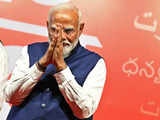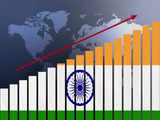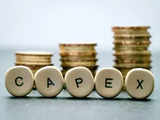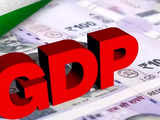Suggest a new Definition
Proposed definitions will be considered for inclusion in the Economictimes.com
Budget
- PREV DEFINITIONGross Budgetary SupportThe government’s support to the Central plan is called Gross Budgetary Support.Read More
- NEXT DEFINITIONHuman Development IndexThe Human Development Index (HDI) is a statistical tool used to measure a country's overall achievement in its social and economic dimensions.Read More
What is 'Gross Domestic Product'
Definition: GDP is the final value of the goods and services produced within the geographic boundaries of a country during a specified period of time, normally a year. GDP growth rate is an important indicator of the economic performance of a country.
Description: It can be measured by three methods, namely,
1. Output Method: This measures the monetary or market value of all the goods and services produced within the borders of the country. In order to avoid a distorted measure of GDP due to price level changes, GDP at constant prices o real GDP is computed. GDP (as per output method) = Real GDP (GDP at constant prices) – Taxes + Subsidies.
2. Expenditure Method: This measures the total expenditure incurred by all entities on goods and services within the domestic boundaries of a country. GDP (as per expenditure method) = C + I + G + (X-IM) C: Consumption expenditure, I: Investment expenditure, G: Government spending and (X-IM): Exports minus imports, that is, net exports.
3. Income Method: It measures the total income earned by the factors of production, that is, labour and capital within the domestic boundaries of a country. GDP (as per income method) = GDP at factor cost + Taxes – Subsidies.
In India, contributions to GDP are mainly divided into 3 broad sectors – agriculture and allied services, industry and service sector. In India, GDP is measured as market prices and the base year for computation is 2011-12. GDP at market prices = GDP at factor cost + Indirect Taxes – Subsidies
Also See: Gross Budgetary Support
Description: It can be measured by three methods, namely,
1. Output Method: This measures the monetary or market value of all the goods and services produced within the borders of the country. In order to avoid a distorted measure of GDP due to price level changes, GDP at constant prices o real GDP is computed. GDP (as per output method) = Real GDP (GDP at constant prices) – Taxes + Subsidies.
2. Expenditure Method: This measures the total expenditure incurred by all entities on goods and services within the domestic boundaries of a country. GDP (as per expenditure method) = C + I + G + (X-IM) C: Consumption expenditure, I: Investment expenditure, G: Government spending and (X-IM): Exports minus imports, that is, net exports.
3. Income Method: It measures the total income earned by the factors of production, that is, labour and capital within the domestic boundaries of a country. GDP (as per income method) = GDP at factor cost + Taxes – Subsidies.
In India, contributions to GDP are mainly divided into 3 broad sectors – agriculture and allied services, industry and service sector. In India, GDP is measured as market prices and the base year for computation is 2011-12. GDP at market prices = GDP at factor cost + Indirect Taxes – Subsidies
Also See: Gross Budgetary Support
- PREV DEFINITIONGross Budgetary SupportThe government’s support to the Central plan is called Gross Budgetary Support.Read More
- NEXT DEFINITIONHuman Development IndexThe Human Development Index (HDI) is a statistical tool used to measure a country's overall achievement in its social and economic dimensions.Read More
Related News
 Six civic bodies likely to debut on Bond Street by next monthNashik, Visakhapatnam, Kanpur, Surat, Varanasi, and Prayagraj are likely to issue municipal bonds by July with a fundraise of Rs 100-300 crore at 7.9-8.3% coupon rate. Municipal bodies have raised nearly Rs 3,000 crore from the bond market in last seven years
Six civic bodies likely to debut on Bond Street by next monthNashik, Visakhapatnam, Kanpur, Surat, Varanasi, and Prayagraj are likely to issue municipal bonds by July with a fundraise of Rs 100-300 crore at 7.9-8.3% coupon rate. Municipal bodies have raised nearly Rs 3,000 crore from the bond market in last seven years Modi govt's fiscal consolidation pace post-Covid worse than peers? Moody's report flags weaker fiscal, debt metricsMoody's rating agency has pointed out that India's fiscal consolidation following the Covid-19 pandemic has lagged behind when compared to its peers. This includes several emerging markets in the Asia-Pacific region.
Modi govt's fiscal consolidation pace post-Covid worse than peers? Moody's report flags weaker fiscal, debt metricsMoody's rating agency has pointed out that India's fiscal consolidation following the Covid-19 pandemic has lagged behind when compared to its peers. This includes several emerging markets in the Asia-Pacific region. A weaker Modi government will slow India's fiscal tightening, Moody's saysIndian PM Modi's narrower election victory limits aggressive fiscal reforms, per Moody's analyst Christian de Guzman. BJP secured 240 seats, with NDA totaling 293. Despite this, fiscal consolidation will persist, but populist spending risks increase. India's fiscal deficit target is 4.5% by 2025/26. Bond yields surged post-election, and Moody's sees stable economic prospects.
A weaker Modi government will slow India's fiscal tightening, Moody's saysIndian PM Modi's narrower election victory limits aggressive fiscal reforms, per Moody's analyst Christian de Guzman. BJP secured 240 seats, with NDA totaling 293. Despite this, fiscal consolidation will persist, but populist spending risks increase. India's fiscal deficit target is 4.5% by 2025/26. Bond yields surged post-election, and Moody's sees stable economic prospects. India's fast economic growth lays firm ground for next governmentIndia's economy grew at a faster-than-expected 7.8% year-on-year in the first three months of 2024, driven by strong performance in the manufacturing sector. This growth pace is expected to support Prime Minister Narendra Modi's economic record, who is hoping to win a rare third term in the national election. The Reserve Bank of India's record surplus transfer of 2.11 trillion rupees ($25.3 billion) will help the next government increase state spending to boost growth.
India's fast economic growth lays firm ground for next governmentIndia's economy grew at a faster-than-expected 7.8% year-on-year in the first three months of 2024, driven by strong performance in the manufacturing sector. This growth pace is expected to support Prime Minister Narendra Modi's economic record, who is hoping to win a rare third term in the national election. The Reserve Bank of India's record surplus transfer of 2.11 trillion rupees ($25.3 billion) will help the next government increase state spending to boost growth. India utilised 99.9% of its capex target in FY24India has used Rs 9,48,506 crore in its capital expenditure in FY24, up from the revised estimate of Rs 9,49,555 crore. The government plans to narrow its fiscal deficit to 5.1% in FY25 from 5.8% in FY24. Private capex is expected to be an important driver of growth and job creation. India's GDP growth was 7.8% in Q4 of FY24, and the overall growth rate is now estimated to be 8.2%.
India utilised 99.9% of its capex target in FY24India has used Rs 9,48,506 crore in its capital expenditure in FY24, up from the revised estimate of Rs 9,49,555 crore. The government plans to narrow its fiscal deficit to 5.1% in FY25 from 5.8% in FY24. Private capex is expected to be an important driver of growth and job creation. India's GDP growth was 7.8% in Q4 of FY24, and the overall growth rate is now estimated to be 8.2%. US inflation rises in line with expectations in AprilU.S. inflation tracked sideways in April, a worrying sign for the U.S. central bank that suggests the elevated pace of price increases could last longer than expected and casts doubt on how soon it will be able to cut interest rates. The personal consumption expenditures (PCE) price index increased 0.3% last month, the Commerce Department's Bureau of Economic Analysis said on Friday, matching the unrevised gain in March.
US inflation rises in line with expectations in AprilU.S. inflation tracked sideways in April, a worrying sign for the U.S. central bank that suggests the elevated pace of price increases could last longer than expected and casts doubt on how soon it will be able to cut interest rates. The personal consumption expenditures (PCE) price index increased 0.3% last month, the Commerce Department's Bureau of Economic Analysis said on Friday, matching the unrevised gain in March. India's GDP grows 7.8 per cent in Q4, FY24 growth pegged at 8.2 per centIndia Q4 GDP: The analysts were anticipating a better-than-expected growth for the January to March quarter this time around. The Reserve Bank of India (RBI) estimated Q4FY24 real GDP growth to be 7 per cent while ET Poll suggested the growth rate of 6.8 per cent. As per a Reuters poll, the Indian economy was expected to grow at 6.7 per cent in the January-March quarter on a year-on-year basis, owing to weak demand.
India's GDP grows 7.8 per cent in Q4, FY24 growth pegged at 8.2 per centIndia Q4 GDP: The analysts were anticipating a better-than-expected growth for the January to March quarter this time around. The Reserve Bank of India (RBI) estimated Q4FY24 real GDP growth to be 7 per cent while ET Poll suggested the growth rate of 6.8 per cent. As per a Reuters poll, the Indian economy was expected to grow at 6.7 per cent in the January-March quarter on a year-on-year basis, owing to weak demand. S&P Global to observe India's fiscal glidepath for ratings upgradeS&P Global Ratings will monitor India's fiscal consolidation efforts over the next two years for a potential sovereign ratings upgrade. Despite raising the outlook to "positive," the rating remains "BBB-." Focus is on India's fiscal deficit reduction targets, fiscal discipline with RBI's surplus transfer, and its ability to manage inflation.
S&P Global to observe India's fiscal glidepath for ratings upgradeS&P Global Ratings will monitor India's fiscal consolidation efforts over the next two years for a potential sovereign ratings upgrade. Despite raising the outlook to "positive," the rating remains "BBB-." Focus is on India's fiscal deficit reduction targets, fiscal discipline with RBI's surplus transfer, and its ability to manage inflation. India should impose tax on ultra-wealthy to tackle wealth inequality, says studyThe paper titled 'Proposals For a Wealth Tax Package to Tackle Extreme Inequalities in India' propose a comprehensive tax package on the ultra-wealthy to tackle the massive concentration at the very top of the wealth distribution and create valuable fiscal space for crucial social sector investments.
India should impose tax on ultra-wealthy to tackle wealth inequality, says studyThe paper titled 'Proposals For a Wealth Tax Package to Tackle Extreme Inequalities in India' propose a comprehensive tax package on the ultra-wealthy to tackle the massive concentration at the very top of the wealth distribution and create valuable fiscal space for crucial social sector investments. Study suggests India should impose wealth tax on the ultra-rich to tackle wealth inequalityA World Inequality Lab study recommends India implement a wealth tax on the ultra-rich to combat wealth inequality and boost social sector investments. Proposed measures include a 2% annual tax on wealth over Rs 10 crore and a 33% inheritance tax on estates exceeding the same value. Authors emphasize the need for progressive taxation to address extreme wealth disparity.
Study suggests India should impose wealth tax on the ultra-rich to tackle wealth inequalityA World Inequality Lab study recommends India implement a wealth tax on the ultra-rich to combat wealth inequality and boost social sector investments. Proposed measures include a 2% annual tax on wealth over Rs 10 crore and a 33% inheritance tax on estates exceeding the same value. Authors emphasize the need for progressive taxation to address extreme wealth disparity.
Load More
Trending DefinitionsSikkim Election Results 2024 Live UpdatesRBI MPC Meeting Live UpdateBudget 2024 Real EstateRailways Budget 2024Interim Budget 2024Budget 2024 New Tax RegimeIncome Tax in Budget 2024Debt fundsRepo rateMutual fundGross domestic productData miningAdvertisingProductMonopolyCryptographyDepreciation